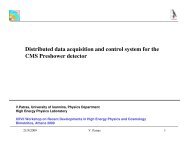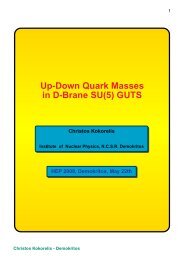Overlooked astrophysical signatures of axion(-like) particles
Overlooked astrophysical signatures of axion(-like) particles
Overlooked astrophysical signatures of axion(-like) particles
Create successful ePaper yourself
Turn your PDF publications into a flip-book with our unique Google optimized e-Paper software.
Magnetic field computed from the Zeemansplitting <strong>of</strong> the Fe I 1564.8 nm line, shown forumbral spectra observed 1998 - 2005. Whilethere is a large variation between differentsunspots, nonparametric tests confirm that thedata show a highly significant trend. The meanvalues for each calendar year are shown as datapoints. (original 906 data points).High-resolution intensity spectra near the Fe i 1564.8nm line at a single umbral point correspond to thedarkest position in 906 sunspots 1998-2005.The samedata set shows a concurrent increase in the normalizedumbral intensity from 0.60 to 0.75 (corresponding to ablackbody temperature rise from 5137 to 5719 K). Themagnetic field and intensity changes observed overtime in the sunspot umbrae from different spotsbehave in the same way as the magnetic field andintensity changes observed spatially across singlesunspots. For B>2500 Gauss. Continuum intensity <strong>of</strong> the umbral spectra,normalized to the intensity <strong>of</strong> the nearby quietSun, shown from 1998 through 2005. A linear fitto the data shows a temperature increase <strong>of</strong>about 73 K / yr.MJ Penn, Livingston, ApJL.649 (20.9.2006)






